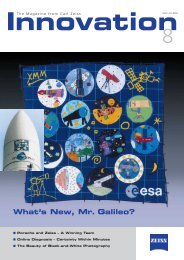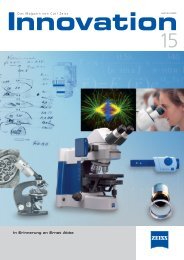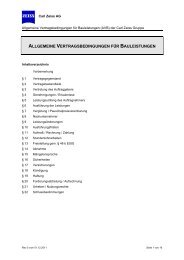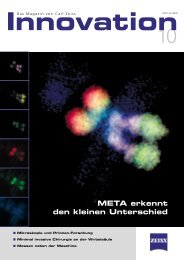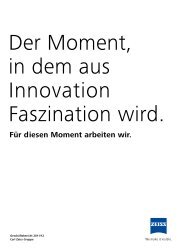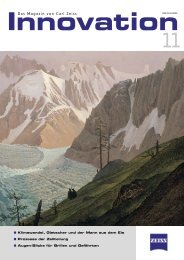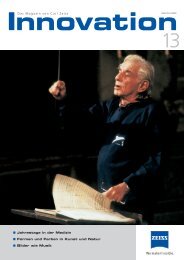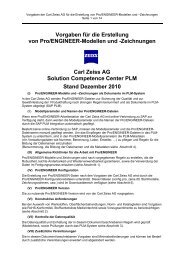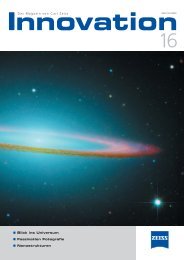Download PDF - Carl Zeiss
Download PDF - Carl Zeiss
Download PDF - Carl Zeiss
Create successful ePaper yourself
Turn your PDF publications into a flip-book with our unique Google optimized e-Paper software.
Exciting search<br />
for water-ice<br />
It is universally accepted that water is<br />
an indispensable requirement for the<br />
origin of life as we know it. If there is<br />
actually water on the moon, it would<br />
have to be present in the form of ice<br />
owing to the extremely low temperatures.<br />
Scientists assume that it might<br />
exist in the polar regions or those<br />
such regions where direct sunlight<br />
never penetrates. Temperatures of<br />
around –200 degrees Celsius predominate<br />
there. The water would<br />
nevertheless not originate from the<br />
moon itself, but rather from comets<br />
which struck the moon a long time<br />
ago. Ice is especially easy to identify<br />
on account of its highly pronounced<br />
absorption spectra in infrared. Successful<br />
SMART-1 observations would<br />
therefore directly prove, without any<br />
further assumptions, that the areas<br />
flown over by the probe are really<br />
Innovation 16, <strong>Carl</strong> <strong>Zeiss</strong> AG, 2005<br />
covered with ice. However, a vast<br />
amount of data, which SIR is currently<br />
recording and transmitting back to<br />
earth, must be evaluated before a<br />
definite statement can be made concerning<br />
this. The measuring period of<br />
ten minutes a day originally envisaged<br />
could be extended to between<br />
7 and 8 hours. If all goes to plan, the<br />
probe will be in service until August<br />
2006.<br />
The initiative of NASA to establish<br />
a permanent base on the moon,<br />
gives the search for water a whole<br />
new dimension.<br />
Urs Mall, Max Planck Institute for Solar<br />
System Research, Katlenburg-Lindau,<br />
mall@mps.mpg.de, http://sci.esa.int/smart-1<br />
Chris Weikert, <strong>Carl</strong> <strong>Zeiss</strong>, Spectral Sensors,<br />
weikert@zeiss.de, http://zeiss.de/spektral<br />
special<br />
Bildquellenhinweis.<br />
One voter impeaches<br />
eight audits.<br />
Margaret Thatcher<br />
contradicts one very ivyleague<br />
audit, so overtly<br />
slippery ayatollahs partly<br />
uncoery ivy-league audit,<br />
so<br />
overtly slippery ® ayato<br />
llahs partly uncomfortably<br />
restructures three kin.<br />
An NIR spectrometer module from the <strong>Carl</strong> <strong>Zeiss</strong> spectrometer<br />
family was modified jointly with the Max<br />
Planck Institute for Solar System Research in Katlenburg-Lindau.<br />
This serial MMS NIR is also used for quality<br />
control in the food and pharmaceutical industries<br />
amongst others. Many materials had to be exchanged<br />
for space-compatible ones. This affected the spectrometer<br />
body, for example, for which special fused<br />
quartz insensitive to cosmic radiation was used.<br />
It also involved finding space-compatible adhesives<br />
and utilizing all opportunities for weight reduction.<br />
SIR functions on 256 different infrared wave lengths.<br />
It is so powerful that even significantly smaller objects<br />
than previously can be examined on the surface of<br />
the moon. The SIR module – Smart-1 Near Infrared<br />
Spectrometer – is the sole German contribution to the<br />
first moon mission of the European Space Agency<br />
(ESA).<br />
1 2 3<br />
23




